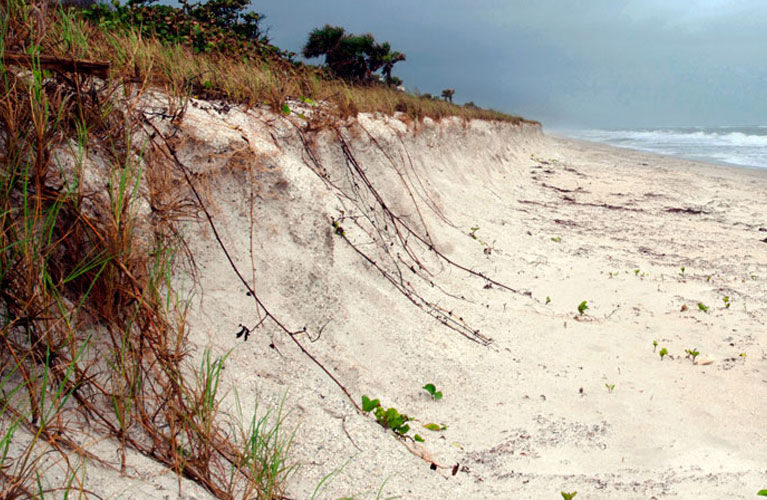
INDIAN RIVER COUNTY — Despite the tens of millions of taxpayer dollars sunk into replenishment of the island’s beaches over the past 36 years, a full 70 percent of Indian River County’s 22.4 miles of shoreline is still categorized as “critically eroded,” according to the first draft of the county’s 2014 beach plan update.
The plan projects that expenditures averaging nearly $8.2 million per year are needed to maintain beaches for recreation, wildlife habitat and protection of property.
Where that money would come from is yet to be determined, and when, where and how it would be spent is sure to become a political issue.
All of Vero’s oceanfront hotels, resorts and restaurants in the main Ocean Drive tourist and shopping area are in a critically eroded zone.
But the City of Vero Beach, known in the beach plan as Sector 5, is not slated for a major sand project for quite a few years.
The county now handles all non-crisis beach replenishment – for the city as well as unincorporated areas – because Vero voters a quarter-century ago approved a referendum prohibiting the city from doing so.
The March 1989 referendum barred the city from placing any sand on beaches “except in the amount necessary to protect life or property during storms or other natural disaster.”
But city officials use the “storms or other natural disaster” loophole to spend money almost every year on emergency dune projects – for example to shore up the Conn Beach boardwalk.
Vero Beach this year budgeted $47,000 for emergency dune repair, although it usually spends more than that.
Before the 2004 hurricanes, only 9.1 miles or 40 percent of the 32963 beaches were in critical condition.
In 2005, that jumped to the current figure of 15.7 miles, which varied slightly the next few years but has been unchanged since 2008.
Basically, there are three swaths of beach along the barrier island that are stable – the south edge of the Turtle Trail beach access south to the north edge of Mariner Village in Indian River Shores, Bay Oak Lane in Old Riomar south to Smugglers Cove in South Beach, and finally, nearly three-quarters of a mile of beach just north of the Indian River/St. Lucie County line near Round Island Park.
John’s Island and Castaway Cove are in the more stable areas. Castaway Cove is a naturally accreting beach, and John’s Island has been the beneficiary of the most recent large scale beach replenishment efforts, as it is directly down-drift from much of the north county project.
Windsor, Sea Oaks, Sandpointe and The Moorings are in critical areas.
The area designated by the county as Sector 5, which runs from Tracking Station Beach to the Riomar Beach Club and encompasses Vero’s Central Beach area, is slated for “minimal beach restoration,” according to the new draft plan compiled by consultants and circulated in late September for public comment.
Vero Beach City Manager Jim O’Connor and various elected officials have repeatedly appealed to the County to devote more of the money that comes from the so-called “bed tax” to beaches within the city, since a large portion of this money is collected inside the City of Vero Beach.
Those pleas, made by O’Connor along with former Councilwoman Tracy Carroll, Vice-Mayor Jay Kramer and most recently by Councilwoman Amelia Graves, have largely been ignored by the county.
The fact that beaches within the Vero city limits are still critically eroded means that battle will likely continue, as the county’s own report estimates the total recreational economic value to the community of the area’s beaches to be $33 million per year.
Arguably, much of that benefit is derived from tourists who stay and play in Vero Beach.
“Yes we are trying to have projects moved up and do feel this beach plan identifies what the city has been saying and Councilmember Amelia Graves has been working the issue as a member of the Beach and Shores Commission,” O’Connor said. “We do feel more money, return on what has been paid and presently being collected in Central Beach in the form of county taxes, should be invested to protect this important asset to Indian River County.”
O’Connor said staff research shows that 53 percent of the bed tax money collected in Indian River County comes from Vero Beach hoteliers. That revenue stream is then used to fund beach projects outside the city limits.
In 2010, the County began working on the north beach project, breaking new ground by using trucked-in sand as opposed to pumping sand from a mile offshore near the outstretched Indian River-St. Lucie County line.
Due to permitting snags, technical difficulties, weather delays and disputes among subcontractors, that $15 million sand-trucking project took three seasons to complete.
Those delays, coupled with scant state funding for beach sand during the recession, pushed projects in other parts of the county like Vero proper further down the road, to 2017 or even 2019.
Just months after replenishment of the area between Windsor and John’s Island was completed, Hurricane Sandy came along offshore in October 2012 and washed much of the sand away, so now the county is working to patch up those north island beaches again, leveraging grants from government agencies.
Each year the work drags on, taxpayers must fund millions of dollars in additional monitoring to make sure the sand doesn’t end up covering the near-shore reef or hard bottom.
If enough sand settles there, the county will need to go back and mitigate that environmental damage by installing artificial reefs.
Overall, despite the fact that a portion of every load of sand pumped or dumped upon the beaches and dunes has and will continue to wash away, consultants conclude that the county’s beach replenishment efforts have successfully held the line on beach erosion.



